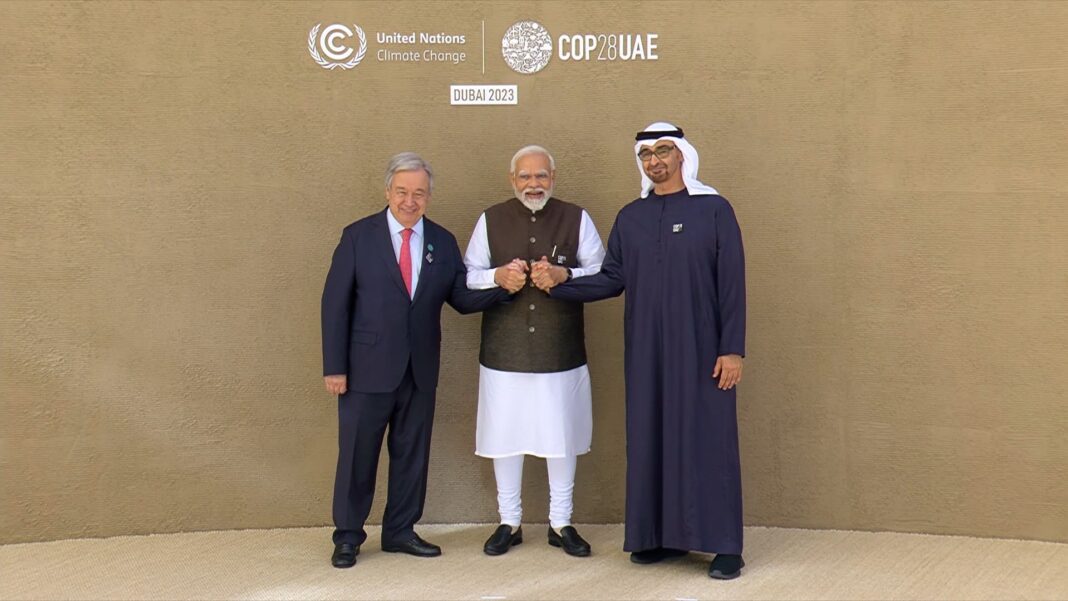Day one of the COP28 climate summit saw the first big breakthrough: agreement on a “loss and damage” fund to compensate poor states for the effects of climate change. Day one of the COP28 climate summit saw the first big breakthrough: agreement on a “loss and damage” fund to compensate poor states for the effects of climate change. Met with a standing ovation in Dubai, the agreement means wealthy states and major polluters will put millions of dollars towards a fund that will in turn distribute funds to poor states harmed by climate change.
The fund will be administered by the World Bank. Initial commitments amount to US$430 million. It will come as a huge relief to the United Arab Emirates, the summit’s host.
The country was under pressure even before talks began about its fossil fuel expansion plans and the fact the president of the climate talks is chief executive of a national oil company. This undoubtedly featured in the UAE’s decision to commit US$100 million to the fund. Other countries to make initial commitments to the fund include the United Kingdom ($75 million), United States ($24.
5 million), Japan ($10 million) and Germany (also US$100 million). Pressure will now build on other wealthy countries, including Australia, to outline their own commitments to the fund. What’s the history of the fund? The Loss and Damage Fund was first suggested by Vanuatu in 1991.
At the heart of the push for this fund is a recognition that those countries likely to be most affected by climate change are the least responsible for the problem itself. The fund would ensure those who created the problem of climate change – developed states and major emitters – would compensate those experiencing its most devastating effects. With global warming now locked in and effects already being felt, from natural disasters to rising sea levels, the fund also recognises the world has failed to prevent climate change from happening.
A commitment to establish such a fund was one of the most important outcomes of last year’s climate talks in Egypt. Since then, a series of meetings had taken place to try to secure international agreement about how the fund would work, who would commit to it, and who would be eligible to receive funds. These meetings have been characterised by significant disagreement over each of these points.
In that sense, the COP28 announcement is a welcome and significant breakthrough. Questions remain There’s still a lot that needs clarifying about this fund. Some of the big outstanding questions include the fund’s size, its relationship to other funds, how it will be administered over the long term, and what its funding priorities will be.
In response to the announcement, leading African think-tank representative Mohamad Adhow noted there were “no hard deadlines, no targets, and countries are not obligated to pay into it, despite the whole point being for rich, high-polluting nations to support vulnerable communities who have suffered from climate impacts”. There is also concern about the World Bank’s role in overseeing the fund in the first instance. Developing countries expressed opposition to this idea in the lead up to COP28, questioning the World Bank’s environmental credentials and the transparency of its operations.
While initial funding may seem generous, most analysts would also agree this fund is a long way from covering the full range of effects. Some estimates suggest the costs of climate-related harms are already at $400 billion annually for developing states: roughly 1,000 times the amount initially pledged. Finally, we should not assume pledges will actually translate to countries putting their hands in their pocket.
The Green Climate Fund announced in 2009 – designed to help developing states with their transition away from fossil fuels and to help with adaptation initiatives – included a commitment for developed states to provide $100 billion per year by 2020. They fell well short of this goal. The legacy agreement on this fund is a good thing in recognising the inequality at the heart of the causes and effects of climate change, and may ultimately be one of the key outcomes of these talks.
Early agreement also means it cannot be used as a bargaining chip over other crucial parts of these negotiations. Now the talks can now focus on the assessment of progress towards meeting commitments to the Paris Agreement, which aims to hold warming to 1. 5°C to limit further dangerous levels of climate change.
Whether the UAE organisers and the rest of the world take up this challenge effectively will determine the effectiveness of these talks, and quite possibly the fate of the planet. .
From: bloombergquint
URL: https://www.bqprime.com/world/cop28-climate-summit-just-approved-a-loss-and-damage-fund-what-does-this-mean



